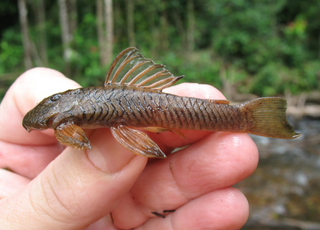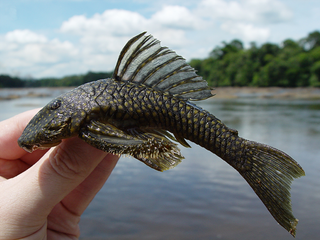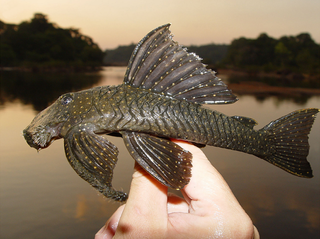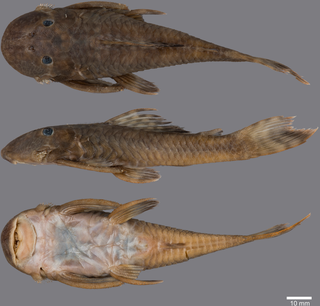
The Amazon basin is the part of South America drained by the Amazon River and its tributaries. The Amazon drainage basin covers an area of about 7,000,000 km2 (2,700,000 sq mi), or about 35.5 percent of the South American continent. It is located in the countries of Bolivia, Brazil, Colombia, Ecuador, Guyana, Peru, Suriname, and Venezuela, as well as the territory of French Guiana.

Loricariidae is the largest family of catfish, with 92 genera and just over 680 species. Loricariids originate from freshwater habitats of Costa Rica, Panama, and tropical and subtropical South America. These fish are noted for the bony plates covering their bodies and their suckermouths. Several genera are sold as "plecos", notably the suckermouth catfish, Hypostomus plecostomus, and are popular as aquarium fish.

The Hypostominae are a subfamily of catfishes of the family Loricariidae. Most members are restricted to tropical and subtropical South America, but there are also several species in southern Central America. Hypostomus plecostomus, which is popular in the aquarium trade, has been introduced to several regions far from its native range.

Guyanancistrus is a genus of suckermouth armored catfishes.

Guyanancistrus nassauensis is a species of catfish belonging to the family Loricariidae, the suckermouth armored catfishes. It is discovered in 2005 and formally described in 2018. G. nassauensis is a rare species, highly endemic to the Nassau Mountains in Suriname, and is threatened with extinction by proposed or ongoing mining activities.
Chaetostoma spondylus is a freshwater species of catfish in the family Loricariidae and the genus Chaetostoma. It is a demersal fish with a pH range of about 6–7.1. It is native to South America, where it occurs in the Chotano River, the Huancabamba River, the Sendamal River, and the Utcubamba, which are mountain tributaries of the Marañón River located at around 1500 to 2000 meters above sea level. These rivers are, by extension, part of the Amazon River basin in Peru.
'Pseudancistrus' megacephalus is a species of catfish in the family Loricariidae. It is of uncertain and disputed classification.
Hypostomus laplatae is a species of catfish in the family Loricariidae. It is native to South America, where it occurs in the Río de la Plata basin. Specimens of H. laplatae have been collected from two rivers, both of which are reported to have sandy substrates and moderate current.
Hypostomus arecuta is a species of catfish in the family Loricariidae. It is a freshwater fish native to South America, where it occurs in the Paraná River in Argentina.

Hypostomus commersoni is a species of catfish in the family Loricariidae. It is native to South America, where it occurs in the Paraná River drainage, including the Iguazu River, the Paraguay River, the Río de la Plata, and the Dulce River. It is typically found in rivers with muddy substrates and moderate currents. The water that H. commersoni inhabits usually has a temperature of 16.8 to 27.8 °C, a pH of 7.2 to 9.2, a turbidity of 23.7 to 442 NTU, an oxygen concentration of 6.1 to 9.1 mg/L, and a conductivity of 1.087 to 2.654 μS/cm.

Guyanancistrus brevispinis is a species of catfish in the family Loricariidae. It is a freshwater fish native to South America, where it occurs in the Atlantic coastal drainages of the Guianas, ranging from the Nickerie River basin to the Oyapock basin in French Guiana and Suriname. It has also been reported from Guyana, but this is believed to be a misidentification. The species is considered the most common and abundant member of the genus Guyanancistrus, occurring in rocky streams with flowing water, especially in the vicinity of plunging waters. It is known to coexist with members of the genus Lithoxus in small forested creeks as well as rapids. The species reaches 14.2 cm in standard length.

Guyanancistrus longispinis is a species of catfish in the family Loricariidae that is of disputed classification. It is native to South America, where it occurs in the Oyapock basin in French Guiana. It is typically seen in shallow rapids with rocky substrates and moderate levels of illumination. It is known to occur alongside the species Guyanancistrus brevispinis, Harttia fowleri, and Crenicichla ternetzi, as well as members of the genus Ancistrus. The species reaches 10.4 cm in standard length and may be a facultative air-breather.

Guyanancistrus niger is a species of catfish in the family Loricariidae that is of disputed classification. It is native to South America, where it occurs in the Oyapock basin in French Guiana. Though reportedly uncommon, it is typically seen in rapids where the species Pseudancistrus barbatus is also present, although the ecological relationship between the two is not known. The species reaches 15.9 cm in standard length, although it has been reported to reach 25.4 cm, and it may be a facultative air-breather.

Guyanancistrus tenuis is a species of catfish in the family Loricariidae. It is native to South America, where it occurs in a forested tributary of the Mapaoni River in the upper Jari River basin in French Guiana, near the Mitaraka Massif, which is a prominent massif in the area. The environment in which the species is typically found is a shallow mountain creek with medium to strong currents, a depth of 20 to 60 cm, and some pools. The species reaches 9.1 cm in standard length. Its specific epithet, tenuis, is derived from Latin and refers to its slender body.

Guyanancistrus teretirostris is a species of catfish in the family Loricariidae. It is a freshwater fish native to South America, where it occurs in the upper Paru de Oeste River in Brazil. The species reaches 9.8 cm in standard length. Its specific epithet, teretirostris, is derived from Latin and refers to the rounded shape of the species' snout.

Cryptancistrus similis is a species of catfish in the family Loricariidae and the only member of the monotypic genus Cryptancistrus. It is a freshwater fish native to South America, where it occurs in the upper Paru de Oeste River in Brazil. The species reaches 6.2 cm in standard length. It was described in 2018 by Sonia Fisch-Muller, Jan Mol, and Raphael Covain as part of a taxonomic review of the genus Guyanancistrus, which Cryptancistrus was found to be distinct from but closely related to. Its specific epithet, similis, is derived from Latin and references the species' similarity to the species of Guyanancistrus, specifically Guyanancistrus brevispinis.
Spatuloricaria terracanticum is a species of catfish in the family Loricariidae. It is native to South America, where it occurs in the Orinoco basin in Colombia. It is typically found in environments at elevations of 197 to 350 m above sea level with moderate slopes, turbid to slightly clear water, a conductivity of 30 to 302 µS/cm, oxygen concentration of 1.6 to 7.64 mg/L, oxygen saturation of 22.5% to 98.8%, pH of between 6.4 and 8.2, temperatures of 22.5 to 28.58 °C, and substrates composed of rocks and sand. The species reaches 28.6 cm in standard length.
Harttiella longicauda is a species of catfish in the family Loricariidae. It is native to South America, where it occurs in mountainous areas in the vicinity of Trinité Massif and Balenfois Massif in northern French Guiana. The species reaches 5.2 cm in standard length. It is known to occur alongside the species Characidium fasciadorsale, Krobia itanyi, Lithoxus planquettei, and Rhamdia quelen, as well as members of the genera Ancistrus, Guyanancistrus, Melanocharacidium, and Rineloricaria. The species was described in 2012 as part of a taxonomic review of members of the loricariid tribe Harttiini native to the Guianas.
Pareiorhaphis garapia is a species of catfish in the family Loricariidae. It is native to South America, where it occurs in the Tramandaí River basin in the state of Rio Grande do Sul in Brazil. It is found upstream of the 12 m (39 ft) high Garapiá waterfall, at elevations higher than 409 m (1,342 ft) above sea level. It is known to occur alongside the species Pareiohaphis nudulus and Rineloricaria aequalicuspis, alongside members of the genera Astyanax and Rhamdia. The species reaches 6 cm (2.4 in) in standard length and is believed to be a facultative air-breather.
Pareiorhina cepta is a species of catfish in the family Loricariidae. It is native to South America, where it occurs in the São Francisco River basin in the state of Minas Gerais in Brazil. It is known to occur alongside the species Astyanax rivularis, Characidium fasciatum, Neoplecostomus franciscoensis, and Trichomycterus macrotrichopterus. The species reaches 4.4 cm (1.7 in) in standard length.











